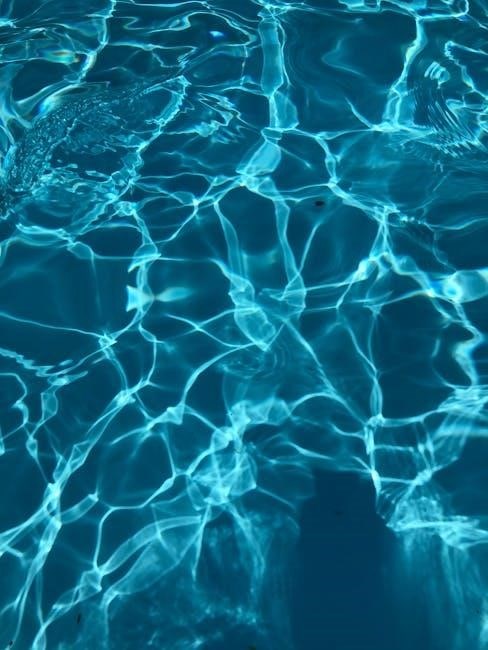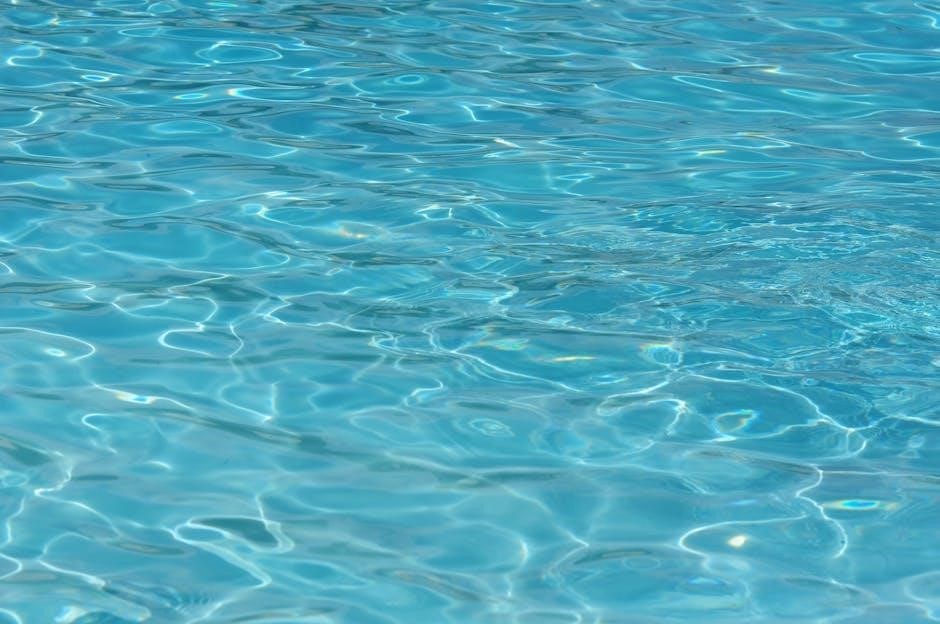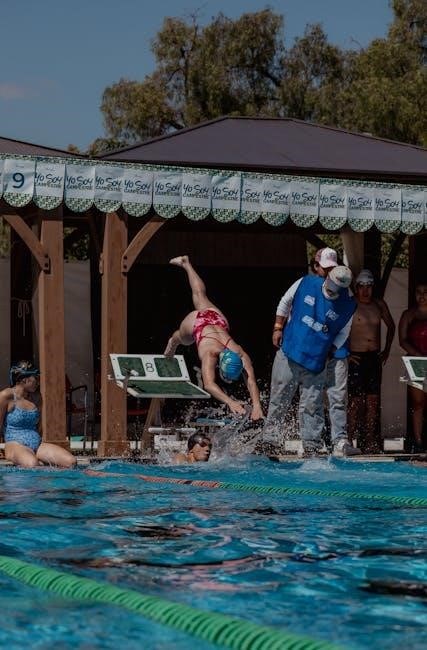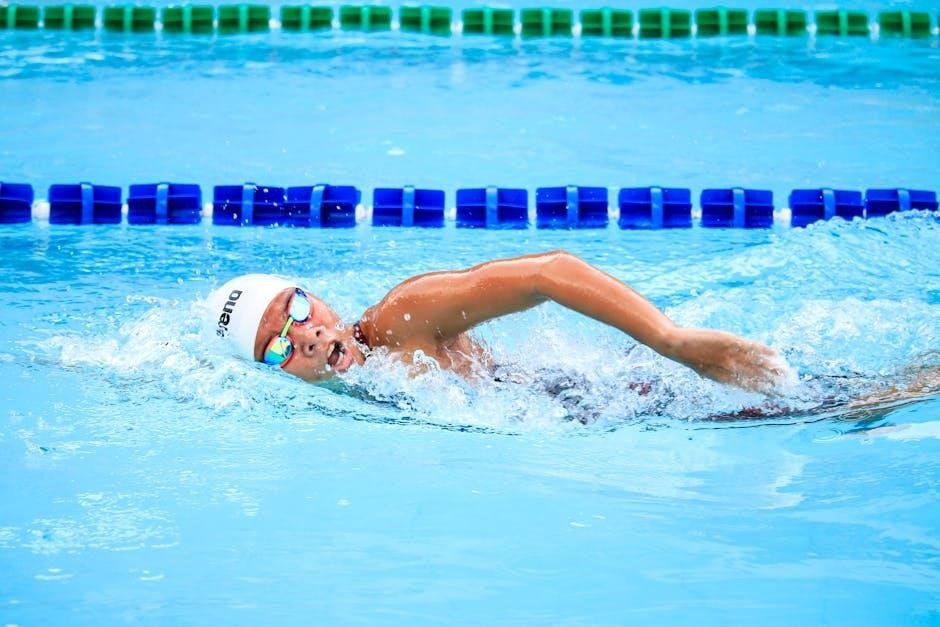Welcome to the Intex swimming pool pump instructions guide. This comprehensive manual will walk you through installation, operation, and maintenance, ensuring safe and efficient pool enjoyment.

1.1 Importance of Proper Pump Installation and Maintenance
Proper installation and maintenance of your Intex swimming pool pump are crucial for ensuring optimal performance, safety, and longevity. A well-installed pump guarantees efficient water circulation, filtration, and heating, which are essential for maintaining clean and safe pool water. Regular maintenance prevents issues like clogged filters, motor damage, or leaks, which can lead to costly repairs or even pose safety risks. By following the guidelines, you can extend the lifespan of your pump, reduce energy consumption, and ensure consistent water quality. Neglecting these steps may result in poor pump performance, increased utility bills, or premature system failure. Proper care ensures your pool remains a enjoyable and safe space for everyone.
1.2 Overview of the Intex Swimming Pool Pump System
The Intex swimming pool pump system is designed to provide efficient water circulation, filtration, and heating for your pool. It typically includes a pump, motor, filter cartridge, hoses, and fittings. The system works by drawing water from the pool, passing it through the filter to remove debris, and then returning clean water back into the pool. This continuous cycle ensures clean and safe swimming conditions. The pump is usually compact, energy-efficient, and designed for easy installation. It is compatible with most Intex above-ground pools and comes with adjustable settings to customize water flow. Regular maintenance ensures optimal performance and extends the system’s lifespan.
Before You Start: Preparing for Pump Installation

Proper preparation ensures a smooth and safe installation process. Gather all components, tools, and safety gear. Familiarize yourself with the instructions and pool setup before proceeding.
2.1 Unpacking and Inventory of Pump Components
Carefully unpack the Intex swimming pool pump and all included accessories. Verify the presence of the pump unit, hoses, fittings, and any additional hardware. Cross-reference each item with the provided inventory list to ensure nothing is missing or damaged. Handle components with care to avoid damage. Familiarize yourself with each part’s purpose to streamline the installation process. If any items are missing or damaged, contact customer support immediately. Properly organize the components in a clean, dry workspace to prevent loss or misplacement. This step is crucial for a successful and stress-free installation experience.
2.2 Checking Compatibility with Your Pool
Before proceeding, ensure the Intex swimming pool pump is compatible with your pool. Verify the pump’s horsepower and flow rate match your pool’s size and type. Check the connection sizes of hoses and fittings to ensure they align with your pool’s existing setup. Confirm the pump’s electrical requirements (voltage and power) are compatible with your pool’s system. Additionally, ensure the pump is suitable for your pool’s water capacity and intended use (e.g., above-ground or inground pools). If unsure, consult your pool’s manual or contact Intex support. Proper compatibility ensures efficient operation and prevents potential damage to the pump or pool system. Always prioritize compatibility to avoid performance issues.
2.3 Safety Precautions and Essential Tools
Before starting, ensure all safety precautions are followed. Always disconnect the pump from power before handling or installing. Wear protective gloves and eyewear to prevent injury. Keep children and pets away during installation. Ensure the area is clear of debris and water to avoid slipping hazards. Gather essential tools: a screwdriver, pliers, wrench, and Teflon tape for connections. For specific Intex models, you may need a hex key or Allen wrench. Refer to your pump’s manual for model-specific tools. Proper preparation and adherence to safety guidelines will ensure a smooth and secure installation process. Never skip safety steps to avoid accidents or damage to the pump.

Installing the Intex Swimming Pool Pump
Installing the Intex swimming pool pump involves placing it on a level surface, connecting hoses, and ensuring all fittings are secure. Follow the step-by-step guide for proper setup and connections.
3.1 Step-by-Step Guide to Pump Installation

Begin by positioning the pump on a flat, stable surface near the pool. Ensure the area is level to prevent vibration and uneven operation. Next, connect the intake hose to the pool’s skimmer or suction port, securing it tightly. Attach the discharge hose to the pump outlet, directing it towards the pool return jet. Tighten all connections using the provided fittings. Plug in the pump, ensuring the power source is grounded and protected from water exposure. Turn on the pump and check for leaks or air bubbles in the connections. Allow the system to run for a few minutes to ensure proper water flow and operation.
3.2 Connecting Hoses and Fittings Correctly
Connecting hoses and fittings properly is essential for efficient water circulation. Start by selecting the correct size and type of hoses for your Intex pool pump. Inspect all connections for damage or wear. Attach the intake hose to the pump’s suction port, ensuring a snug fit. Use the provided adapters if necessary. Secure the discharge hose to the pump outlet, directing it to the pool’s return jet. Tighten all connections firmly to prevent leaks. Double-check for any air leaks by running the pump briefly. Properly connected hoses ensure optimal water flow and prevent damage to the pump. Always follow the manufacturer’s guidelines for fitting compatibility and tightening torque.
Operating the Intex Swimming Pool Pump
Operating the Intex pool pump involves turning it on, adjusting settings, and monitoring performance. Ensure the pump runs smoothly, maintaining clean water and efficient circulation for your pool.
4;1 Understanding Pump Controls and Settings
Understanding the Intex pool pump controls and settings is essential for optimal operation. The pump features a power button, speed settings, and a timer. The power button turns the pump on/off, while speed settings allow you to adjust flow rate. The timer enables automatic operation, saving energy. Familiarize yourself with the pressure gauge to monitor system performance. Adjust settings based on pool size and usage to ensure efficient water circulation. Proper use of controls ensures clean water, reduces wear, and prolongs pump life. Always refer to the control panel diagram in your manual for clarity.
4.2 Best Practices for Daily Pump Operation
For optimal performance, follow these best practices for daily operation of your Intex pool pump. Run the pump during the recommended 8-12 hours daily, ideally during daylight to reduce energy costs. Always ensure the skimmer basket and filter cartridge are clean to maintain proper water flow. Check the water level in your pool, as low levels can strain the pump. Monitor the pressure gauge to avoid overloading the system. Adjust the pump’s speed settings based on pool usage and cleanliness needs. Regularly inspect hoses and connections for leaks or damage. Consistent operation ensures clean, safe, and energy-efficient pool maintenance.
4.3 Monitoring Pump Performance and Water Flow
Regularly monitoring your Intex pool pump’s performance ensures efficient operation and prolongs its lifespan; Check the pressure gauge to ensure it stays within the recommended range, as high pressure can indicate blockages. Verify that water flows smoothly through the return jets and skimmer, ensuring even circulation. Listen for unusual noises, which may signal issues like air leaks or clogged hoses. Inspect the hoses and connections for tightness and damage. Monitor the filter cartridge for cleanliness, as a dirty filter can reduce water flow. Adjust the pump’s settings if you notice weak flow or poor water clarity. Consistent monitoring helps maintain optimal performance and prevents potential damage.

Maintaining and Cleaning the Pump
Regular maintenance and cleaning are crucial for the longevity and efficiency of your Intex pool pump. This section provides essential tips and schedules to keep it running smoothly.
5.1 Regular Maintenance Schedule for Optimal Function
To ensure your Intex pool pump operates efficiently, follow a regular maintenance schedule. Check and clean the filter cartridge weekly, and inspect hoses for any signs of wear or damage; Monthly, lubricate moving parts and ensure all connections are tight. Every three months, perform a thorough cleaning of the pump basket and skimmer. Additionally, monitor the pump’s performance and address any unusual noises or drops in water flow promptly. By adhering to this schedule, you can prevent major issues, extend the pump’s lifespan, and maintain clean, safe pool water for enjoyable swimming experiences throughout the season.
5.2 Cleaning the Pump and Filter Cartridge
Cleaning the pump and filter cartridge is essential for maintaining optimal performance and water quality. Start by turning off the pump and disconnecting the power source. Remove the filter cartridge and rinse it thoroughly with a garden hose to eliminate dirt and debris. For stubborn stains, soak the cartridge in a mild detergent solution before rinsing. Reassemble the pump and cartridge, ensuring all connections are secure. Regular cleaning prevents clogs, improves water circulation, and extends the lifespan of your Intex pool pump. Always follow the manufacturer’s guidelines for cleaning frequency and methods to ensure efficiency and safety.

Safety Considerations and Precautions
Always follow safety guidelines when operating the Intex pool pump. Ensure proper electrical connections, avoid overloading, and keep children away. Regular inspections prevent accidents and ensure longevity.
6.1 General Safety Tips for Pump Usage

Ensure the pump is installed on a level, stable surface to prevent vibration and tipping. Always follow the manufacturer’s guidelines for electrical connections to avoid shocks or fires. Keep the pump at least 10 feet away from the pool to reduce accident risks. Regularly inspect hoses and connections for damage or leaks. Never operate the pump near open flames or sparks. Keep children and pets away from the pump while it’s running. Avoid overloading the pump, as this can cause overheating. Always turn off the pump before cleaning or performing maintenance. Proper grounding of the pump is essential to prevent electrical hazards. Follow these tips to ensure safe and efficient operation.
6.2 Handling Emergencies and Shutdown Procedures
In case of an emergency, immediately turn off the pump and disconnect it from the power source. If the pump overheats, stop operation and allow it to cool before restarting. For electrical issues, unplug the pump and contact a licensed electrician. If water leaks or flooding occurs, shut off the pump and drain the area. Never attempt repairs while the pump is operational. In case of a malfunction, refer to the troubleshooting section. Always follow proper shutdown procedures to prevent damage or injury. Regular inspections can help prevent emergencies. Keep emergency contact information handy and ensure all users understand shutdown protocols. Safety should always be the top priority.
Troubleshooting Common Issues
Identify and resolve issues like low water flow, pump not starting, or unusual noises. Check for clogs, proper connections, and power supply. Refer to the troubleshooting section for detailed solutions.

7.1 Identifying and Resolving Common Pump Problems
Common issues with Intex pool pumps include low water flow, pump not starting, or excessive noise. Check for clogged hoses, dirty filters, or improper connections. Ensure the pump is on a level surface and all valves are open. If the pump doesn’t start, verify power supply and reset the breaker if necessary. For noise, inspect for loose parts or debris. Regularly clean the filter cartridge and ensure proper installation of all components. Refer to the troubleshooting guide for step-by-step solutions to restore optimal performance and extend the pump’s lifespan. Addressing issues promptly prevents further damage and maintains efficient pool operation.
7.2 Resetting the Pump and System
To reset the Intex pool pump, first, turn off the power at the breaker box and ensure the pump is unplugged. Inspect the system for blockages or air leaks in hoses and connections. Check the filter cartridge for cleanliness and proper installation. Verify that all valves are open and the pump basket is clear of debris. Once issues are resolved, plug in the pump, turn the power back on, and monitor its operation. If the pump still doesn’t function, consult the user manual or contact customer support for further assistance. Resetting correctly ensures smooth operation and prevents potential damage to the system.

By following these instructions, you’ll ensure your Intex pool pump operates safely and efficiently. Regular maintenance and proper usage will extend its lifespan and performance. Always refer to this guide for troubleshooting and best practices to enjoy a clean, functional pool year-round.
8.1 Summary of Key Instructions and Best Practices
Proper installation, regular maintenance, and safe operation are crucial for optimal performance. Always follow the manufacturer’s guidelines and safety precautions. Ensure the pump is correctly sized for your pool and installed on a level surface. Regularly clean the filter cartridge and check for wear and tear. Monitor water flow and pressure to prevent damage. Keep the area around the pump clear and dry to avoid accidents. Refer to the troubleshooting section for common issues and solutions. By adhering to these best practices, you’ll extend the lifespan of your Intex pool pump and enjoy a clean, safe, and functional swimming pool experience.
8.2 Ensuring Long-Term Efficiency and Safety
To maintain your Intex pool pump’s efficiency and safety, prioritize regular maintenance and adhere to best practices. Clean the filter cartridge frequently and inspect hoses for damage. Ensure proper water circulation by adjusting pump settings according to pool size and usage. For energy efficiency, run the pump during off-peak hours and use a timer. Always keep the pump area clear of debris and water to prevent electrical hazards. Supervise children and pets near the pump. Address any issues promptly to avoid costly repairs. By following these guidelines, you’ll enjoy a reliable, efficient, and safe pool experience for years to come.
